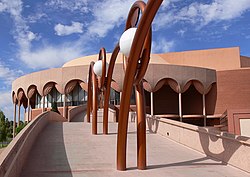1885–1929[edit]
Originally named the Tempe Normal School, the institution was founded on March 12, 1885, after John Samuel Armstrong first introduced House Bill 164, "An Act to Establish a Normal school in the Territory of Arizona to the13th Legislative Assembly of the Arizona Territory. Instruction was instituted on February 8, 1886 under the supervision of Principal Hiram Bradford Farmer. Land for the school was donated by Tempe residents George and Martha Wilson, allowing 33 students to meet in a single room.[25]
At the beginning of the 20th century, the school's name was changed from Tempe Normal School to the Arizona State Teachers College at Tempe. Before becoming a college, the Normal School enrolled high school students with no other secondary education facilities. Under the 30 year tenure of president Arthur John Matthews the school was given all-college student status. The first dormitories built in the state were constructed under his supervision. Of the 18 buildings constructed while Matthews was president, six are still currently in use. Matthews envisioned an "evergreen campus," with many shrubbery brought to the campus. He also implemented the planting of Palm Walk, now one of the feature landmarks of the Tempe campus. His legacy is being continued to this day with the main campus having the honor of being declared a nationally recognized arboretum.[26]
During the Great Depression, Ralph W. Swetman was hired as president for a three-year term.[27] Although enrollment increased by almost 100% during his tenure due to the depression, many faculty were terminated and faculty salaries were cut.[28]
1930–1989[edit]
In 1933, Grady Gammage, then president of Arizona State Teachers College at Flagstaff, became president of Arizona State Teachers College at Tempe, a tenure that would last for nearly 28 years. Like his predecessor, Gammage oversaw the construction of a number of buildings on the Tempe campus. Dr. Gammage oversaw the development of the university, graduate programs, and the renaming of the Arizona State College to Arizona State University in 1958.
By the 1960s, with the presidency of Dr. G. Homer Durham, Arizona State University began to expand its academic curriculum by establishing several new colleges and beginning to award Doctor of Philosophy and other doctoral degrees.[29]
The next three presidents—Harry K. Newburn, 1969–71, John W. Schwada, 1971–81, and J. Russell Nelson, 1981–89—and Interim President Richard Peck, 1989, led the university to increased academic stature, creation of the West Campus, and rising enrollment.



.jpg)



